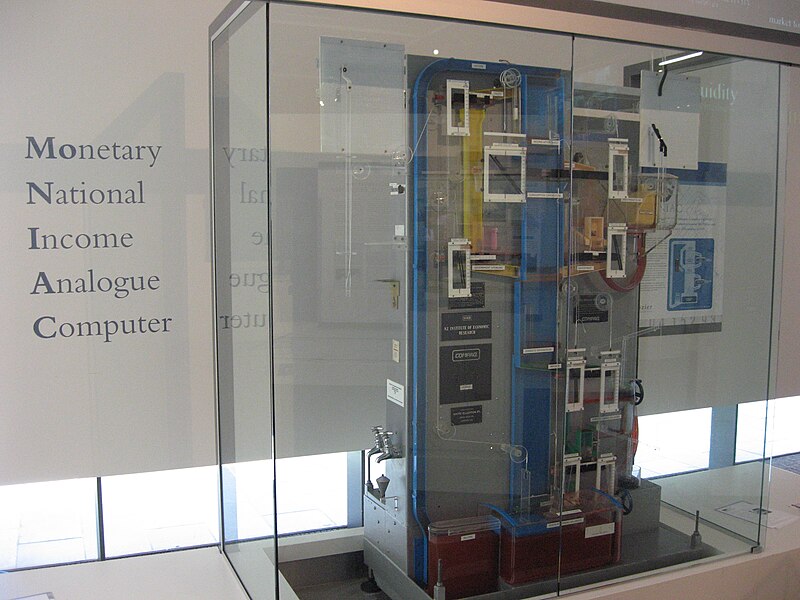"Looking at current macroeconomic policy, the obvious question is, stupid or evil? And the obvious answer is, why do we have to choose?
But it is, I think worthwhile – or at any rate soothing – to think about the longer-term future for monetary and fiscal policy. I recently talked about some of these issues with Adair Turner, and I thought I might write up my version of the story so far (just to be clear, Adair bears no responsibility for any errors or confusion in what follows). In brief, there is a case for believing that the problem of maintaining adequate aggregate demand is going to be very persistent – that we may face something like the “secular stagnation” many economists feared after World War II.
So, let’s start with the basic role of monetary policy in stabilizing the economy. Many, probably most macroeconomists – or at any rate those who think at all about policy – think of that role something like this:
 Figure 1: Normal monetary policy
Figure 1: Normal monetary policy
Here IS shows how overall real spending and hence the level of real GDP depends on the real interest rate. We think of the central bank as being able to set the real interest rate; its goal is to set that rate at a level that keeps the economy near potential output, which in turn is consistent with low and stable inflation. This is equivalent conceptually to setting the rate at the Wicksellian natural interest rate.
Not that long ago, macroeconomists were congratulating central bankers (and central bankers were, of course, congratulating themselves) over doing a pretty good job of getting this right. Inflation, occasional commodity shocks aside, was indeed low and stable, and from 1985 to 2007 the real economy was fairly stable too.
 Figure 2: Inflation was good …
Figure 2: Inflation was good …
Then came catastrophe – and as so often happens, when the house collapses you find the skeletons that were lurking in the closet all along. The stability of prices and output masked an underlying unsustainable growth in leverage:
 Figure 3: … but trouble was brewing. Household liabilities as percent of GDP.
Figure 3: … but trouble was brewing. Household liabilities as percent of GDP.
It was a Minsky moment waiting to happen, and happen it did.
When the Minsky moment came, there was a rush to deleverage; this drove down overall demand for any given interest rate, and made the Wicksellian natural rate substantially negative, pushing us into a liquidity trap:
 Figure 4: The liquidity trap.
Figure 4: The liquidity trap.
This meant that monetary policy could no longer do the job of stabilizing the economy: Central banks found themselves up against the zero lower bound. Fiscal policy could and should have helped, and automatic stabilizers did help mitigate the slump. But fiscal discourse went completely off the rails, and overall we had unprecedented austerity when we should have had stimulus.
So we’ve had an economic disaster – and our inability to avoid this disaster makes a mockery of all the self-congratulation of the years that preceded it.
But how should pre-2008 policy have been different? And what should policy look like looking forward?
There are many economic commentators who take rising leverage, asset bubbles and all that as prima facie evidence that monetary policy was too loose; some argue that the Fed kept rates too low for too long after the 2001 recession, some argue that interest rates were too low over the whole period from 1985 to 2007.
The trouble with this line of argument is that if monetary policy is assigned the task of discouraging people from excessive borrowing, it can’t pursue full employment and price stability, which are also worthy goals (as well as being the Fed’s legally binding mandate). Specifically, since the US economy shows no signs of having been overheated on average from 1985 to 2007, the argument that the Fed should nonetheless have set higher rates is an argument that the Fed should have kept the real economy persistently depressed, and unemployment persistently high – and also run the risk of deflation – in order to keep borrowers and lenders from making bad decisions. That’s quite a demand.
Many of us would therefore argue that the right answer isn’t tighter money but tighter regulation: higher capital ratios for banks, limits on risky lending, but also perhaps limits for borrowers too, such as maximum loan-to-value ratios on housing and restrictions on second mortgages. This would guard against bubbles and excessive leverage, while leaving monetary policy free to pursue conventional goals.
Or would it?
Our current episode of deleveraging will eventually end, which will shift the IS curve back to the right. But if we have effective financial regulation, as we should, it won’t shift all the way back to where it was before the crisis. Or to put it in plainer English, during the good old days demand was supported by an ever-growing burden of private debt, which we neither can nor should expect to resume; as a result, demand is going to be lower even once the crisis fades.
And here’s the worrisome thing: what if it turns out that we need ever-growing debt to stay out of a liquidity trap? What if the economy looks like Figure 4 even after deleveraging is over? Then what?
This is not a new fear: worries about secular stagnation, about a persistent shortfall of demand even at low interest rates, were very widespread just after World War II. At the time, those fears proved unfounded. But they weren’t irrational, and second time could be the charm.
Bear in mind that interest rates were actually pretty low even during the era of rising leverage, and got worryingly close to zero after the 2001 recession and even, you might say, after the 90-91 recession (there was talk of a liquidity trap even then). It’s not hard to believe that liquidity traps could become common, if not the norm, in an economy in which prudential action, public and private, has brought the era of rising leverage to an end.
And in that case, then what?
We might try to figure out why we seem to need leverage and bubbles to have full employment, and try to fix it. More thoughts on that on another day. But what if that isn’t an option?
One answer could be a higher inflation target, so that the real interest rate can go more negative. I’m for it! But you do have to wonder how effective that low real interest rate can be if we’re simultaneously limiting leverage.
Another answer could be sustained, deficit-financed fiscal stimulus. But, you say, this would lead to exploding public debt! Actually, no – not if the real interest rate is persistently below the economy’s growth rate, which it will certainly be if it’s persistently negative. In that case the government can run a primary deficit even while keeping the debt-GDP ratio constant – and the higher the level of debt, the higher the allowable deficit.
OK, I’m shooting from the hip here. The main point is simply that the weirdness of our current situation may well go on much longer than anyone currently imagines"

































